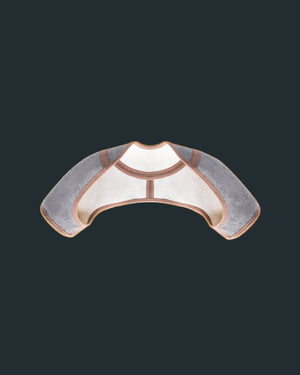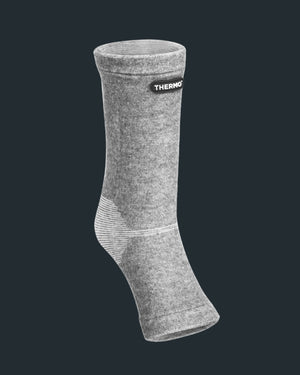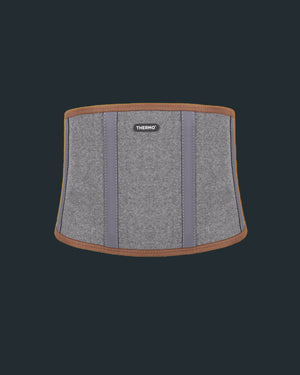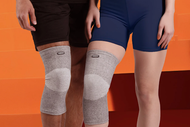The knee joints are among the most stressed joints in your body because they’re often tasked with carrying your body weight.
The knee joints are among the most stressed joints in your body because they’re often tasked with carrying your body weight.
Accordingly, keeping the strength and the range of motion of such joints can make your movement easier and potentially reduce pain.
We’ll show you six effective exercises for enhancing your knee’s mobility. So whether your knees are healthy or you’re suffering from an injury, there will be an exercise for you.
So, let’s dive into the knee mobility exercises you need to know about!
6 Knee Strengthening Exercises to Enhance Your Knee’s Mobility
Disclaimer: If you have any physical conditions, your therapist or physician must check the following exercises before you attempt them.
1. Thigh Contraction
The thigh contraction exercise increases the strength of your quadriceps, contributing greatly to your legs’ movement.
To do this exercise, sit on a comfortable chair and extend one of your legs ahead of you. Try to focus on contracting the quadriceps to get the most out of the exercise. Pulling your toes up without touching them with your hands can help achieve that contraction.
You know you’re doing the exercise right when you feel a burning sensation in your thigh muscles, indicating that they’re currently engaged. Hold the straight leg position for 15 seconds, and do three sets per leg.
Since this exercise doesn’t use weight, it’s suitable for those with knee injuries.
2. Squats
Squats are popular exercises that target most of the muscle groups in your leg, including the quadriceps, hamstrings, and calf muscles.
The basic squat involves bending your knees as if you’re sitting on an imaginary chair, with your hips and thighs parallel to the floor.

However, unlike thigh contraction, squats are still a challenging exercise that not everyone can do despite just using body weight. As such, pick the suitable variation from the following according to your condition:
Wall Squats
Wall squats are the easiest form of squats because they provide enough support to your back to prevent excess tension on the ligaments and tendons around your knee joint. As such, it’s often a helpful exercise to strengthen your knee and improve its mobility after an injury.
If you want to minimize the friction between your back and the wall, place an exercise ball behind your back and slowly lower yourself to maintain balance.
Regular Squats
Regular or basic squats are the middle ground, and they can be performed by most healthy people as long as they don’t have any knee conditions that render this exercise dangerous.
Weighted Squats
Weighted squats go beyond knee mobility to improve your legs' overall strength and balance. It’s highly recommended to have supervision during the first time you perform this exercise to avoid injury.
You can perform weighted squats using dumbbells or barbells.
Note: Regardless of the variation, as a beginner, aim for 10 reps of three sets. As you advance, you can progress with the reps or weights (in the case of weighted squats).
3. Heel Slides
Heel slides take a step down from the difficulty of squats and can be done with or without equipment.
The exercise improves your knee's range of motion and stability while lying on your back, preventing any damage that an awkwardly performed squat can inflict.
To perform a basic heel slide, lay down on your back in a comfortable position, then pull your knee toward your belly without using your hand.
Don’t let your knee touch your belly. The ideal position is having your knee bent at a 90° angle. Keep your leg bent for a couple of seconds, then slowly straighten your leg back on the floor, then switch legs.
To get the most out of heel slides, do the exercise in a slow, controlled manner, and keep your upper body relaxed before you move to the opposite leg. To increase the difficulty, use a resistance band to add muscle growth to your workout.
Do three sets of 15-20 reps per leg to complete the exercise.
4. Standing Hamstring Curls
Standing curls are one of the most excellent knee mobility and balancing exercises because they’re safe and easy to learn. They also improve the strength of the tendons and ligaments surrounding your ankles and knees.
To perform the first level of this exercise, stand with your hands on a chair, table, or even a wall for balance. Bend one knee backward until it forms a 90° angle, hold the position for two seconds, and then switch legs.
You may add an extra challenge by not holding a chair or a table; this forces your knees to control your balance, which helps strengthen them.
If the exercise feels too easy, tie your leg to the chair or the table leg using a resistance band. If there’s no object to tie your leg to, you can stand on the band with the idle leg. This adds an extra strength to your hamstrings.
Whichever difficulty level you prefer, aim for 10 reps per leg for three sets.
5. Lunges
Lunges can help you focus on your knee joints individually, which is helpful if one knee is weaker than the other.
Much like squats, lunges can be done with or without weights, but since your goal is to improve your knee’s mobility is your goal, you should focus on bodyweight lunges.

To do a lunge, stand with your feet shoulder-width apart and your knees slightly bent on a flat surface. Take a step forward (say, the left leg) and lower your hips until you form a 90° angle with both of your legs.
Your front knee shouldn’t be ahead of your front foot, and your back knee shouldn’t touch the ground. Use your left knee to push yourself back to the starting position.
Do three sets of 10 lunges for each leg to complete the exercise.
6. Step Ups
Step-ups are among the common exercises used to improve the thigh muscle groups during osteoarthritis therapy.
Doing a step up is as simple as it gets. You bend one of your knees and get on the step as if you’re climbing stairs, then follow with the other leg.
While step-ups can be done quickly to improve cardio, your aim here is to improve knee mobility and balance, so it’s best to utilize slow and controlled motions.
You may also use a band to increase resistance and strengthen muscles and tendons surrounding the knees.
Don’t Forget to Recover
After doing these knee mobility exercises, it’s important to practice muscle recovery because it prevents fatigue and reduces the risk of injury. It also helps your muscles to grow and actually utilize the exercise for maximum benefit; otherwise, you’ll find yourself overtraining without good progress.
Besides rest, healthy food, and hydration, a crucial part of recovery is providing adequate blood flow to the target joint and the surrounding soft tissues.
Normally, our bodies do that on their own, but if you want to speed up the process, consider using recovery wear. It uses compression to help you relieve muscle pain, improve blood flow, and rebuild muscles post-exercise.
Final Words
Listed above are six of the best knee mobility exercises you can do with minimum equipment. However, make sure to consult your physical therapist before you attempt a new exercise, as your current condition may not allow you to exceed certain thresholds of pressure over your knee joint.
We recommend pairing these exercises with recovery knee sleeves, such as our Thermo™ Lite Recovery Knee Sleeve, to naturally speed up your healing process.
Our knee sleeve is made from bamboo charcoal which helps release infrared waves into your body to improve blood flow and reduce chronic pain by over 60%. As such, it can be worn by anyone with various knee conditions.
Sources
- Walking for Exercise May Prevent Knee Pain | Harvard Health Publishing
- Knee Facts | The Orthopedic Clinic
- Stretches and Exercises to Strengthen Your Knees, from a PT | Hospital for Special Surgery
- How to Strengthen Your Knee | Medical News Today
- 5 Great Exercises to Strengthen Your Knees | Ability Rehabilitation
- Knee Mobility Exercises | Sports Injury Clinic






